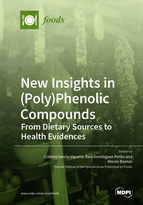New Insights in (Poly)Phenolic Compounds: From Dietary Sources to Health Evidences
A special issue of Foods (ISSN 2304-8158). This special issue belongs to the section "Food Nutrition".
Deadline for manuscript submissions: closed (1 November 2019) | Viewed by 39282
Special Issue Editors
2. Associated Unit of R&D and Innovation CEBAS-CSIC+UPCT on “Quality and Risk Assessment of Foods”, CEBAS-CSIC, Campus Espinardo - 25, E-30100 Murcia, Spain
Interests: food science and technology; phytochemistry; bioactive compounds; health promoters; functional ingredients, beverages and foods; natural and minimally processed foods; healthy foods; energy metabolism (obesity, diabetes); chronic inflammation; human nutrition; wellbeing
Special Issues, Collections and Topics in MDPI journals
Interests: lipidomics; plant oxylipins; bioaccessibility; bioavailability; bioactivity; structure-activity relationship (SAR); in vitro models of biological activity; inflammation; oxidative stress; immune system
Special Issues, Collections and Topics in MDPI journals
Interests: bioactive compounds of vegetable origin; nutrition and health; development of new plant foods and natural products; pharmacology applications; in vitro and in vivo animal models; bioaccessibility, pharmacokinetics, and bioavailability of bioactive compounds
Special Issues, Collections and Topics in MDPI journals
Special Issue Information
Dear Colleagues,
This Special Issue is intended to cover the existing gap between classical studies and the occurrence of new types of (poly)phenol derivatives (e.g., lipophenols) that have been scarcely explored to-date. We are also interested in the influence of the digestive process on the bioaccessibility and bioavailability of these compounds and the advantages of nanoencapsulation and their application in functional foods, which could allow research focusing on the actual biological dimension of (poly)phenols. Additionally, we welcome reports on the current strategies to enhance the content of these bioactives in foods; on setting up formulations that increase their bioaccessibility, bioavailability, and bioactivity; and on the determination of their mechanism of action through in vitro and in vivo models. Altogether, these would expand the application of these compounds in the clinical frame, thus reducing the application of pharmacological treatments while envisaging a new horizon for therapy. The successful achievement of these objectives can only be done by bringing together the contributions of multidisciplinary experts working in the diverse fields of food, nutrition, and health.
Prof. Cristina García-Viguera
Dr. Raúl Domínguez-Perles
Dr. Nieves Baenas Navarro
Guest Editors
Manuscript Submission Information
Manuscripts should be submitted online at www.mdpi.com by registering and logging in to this website. Once you are registered, click here to go to the submission form. Manuscripts can be submitted until the deadline. All submissions that pass pre-check are peer-reviewed. Accepted papers will be published continuously in the journal (as soon as accepted) and will be listed together on the special issue website. Research articles, review articles as well as short communications are invited. For planned papers, a title and short abstract (about 100 words) can be sent to the Editorial Office for announcement on this website.
Submitted manuscripts should not have been published previously, nor be under consideration for publication elsewhere (except conference proceedings papers). All manuscripts are thoroughly refereed through a single-blind peer-review process. A guide for authors and other relevant information for submission of manuscripts is available on the Instructions for Authors page. Foods is an international peer-reviewed open access semimonthly journal published by MDPI.
Please visit the Instructions for Authors page before submitting a manuscript. The Article Processing Charge (APC) for publication in this open access journal is 2900 CHF (Swiss Francs). Submitted papers should be well formatted and use good English. Authors may use MDPI's English editing service prior to publication or during author revisions.
Keywords
- plant foods
- flavonoids
- extracting methods
- in vitro and in vivo functionality
- bioaccessibility and bioavailability
- nutritional studies
- pre-clinical and clinical trials
- metabolism
- health








